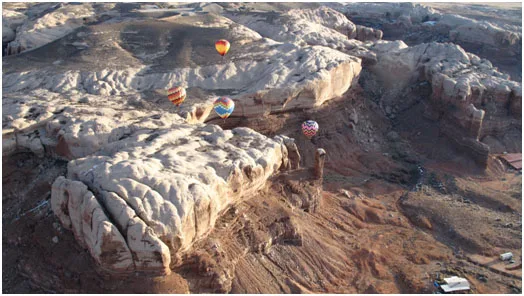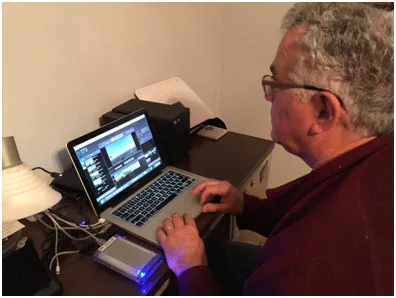Spreading Aerial Enjoyment
 It’s somewhat ironic that a 20-year Navy veteran would retire in the frozen tundra of Wisconsin and spend most of his free time around flying machines. But John Ross is a master of anomalies.
It’s somewhat ironic that a 20-year Navy veteran would retire in the frozen tundra of Wisconsin and spend most of his free time around flying machines. But John Ross is a master of anomalies.
He was also a college IT instructor for 24 years and currently hosts a technology talk show, has served as co-chairman of Flight Line Operations at the EAA’s (Experimental Aircraft Association) Airventure Oshkosh and is a self-described hot-air balloon experience sharer.
Airventure Oshkosh is an annual week-long air show held in Oshkosh, Wisconsin that attracts aircraft of every type from around the globe. This year, more than 14,000 aircraft were viewed by more than a half million people.
“The air show is an excellent opportunity for young and old to get up close and personal with some of the coolest aircraft people build, work on and fly,” he noted. “It’s a lot of fun for everyone but it’s also a logistical nightmare and every year, the committee of volunteers is amazed that it actually comes together and runs so smoothly.”
 It’s probably no surprise that he “escapes” the bedlam by taking to the skies himself. The difference is he does it in silence in a hot air balloon.
It’s probably no surprise that he “escapes” the bedlam by taking to the skies himself. The difference is he does it in silence in a hot air balloon.
“Floating over the landscape and maneuvering over the countryside, especially the rising spires and rock walls of the southwest, is great therapy,” he explained. “But over the past two years, I really wanted to share these adventures and the work/fun of hot-air ballooning with a wider audience.”
As a result, he tapped his other passion, visual story telling to create a series of HD documentaries to highlight the beauty of ballooning. He wanted to tell the whole story, including the hard work that accompanies the flights as well as the tight-knit community of balloonists.
Over the years, Ross has participated in balloon invitational festivals that accept 20 – 200 balloon pilots. The most spectacular is the Albuquerque International Balloon Festival (600+ balloons), with the International Hot-Air Balloon Festival in Leon, Mexico, which attracts some of the most colorful and unusual shaped aircraft in existence as a close second.
“Events like these are great for the chosen few,” Ross said, “but hour-long films of drifting by some breathtaking landscape is great for viewers, including balloon pilots, but they only tell a fraction of the story for the average person.
“I wanted to produce shorter films (10-15 minutes) documenting different events and different locations that let people feel as though they are an active participant in the day’s activities,” he added.
One of the first was “Playing on the Rocks,” a film that was done in partnership with Brady Lane (EAA). The film is about the growing event near Gallup, New Mexico that attracts more than 31 participants and is now available on YouTube — http://tinyurl.com/qhowszk.
The 11-minute film was shot in the Red Rocks National Park in New Mexico.
Most of the festival events are strictly invitational and his goal is to broaden interest in the sport–not just to get people to acquire and fly balloons, but also participate as ground crew and occasional passengers.
Ross is currently editing and producing two more films:
- “Dancing in the Valley of the Gods” — One of the most widely photographed and filmed areal scenes in Utah, Ross wanted to complete the Valley of the Gods first because it is the one location that he says will really hook you on the majesty of ballooning.
- “The Albuquerque International Balloon Festival (AIBF)” – A film of the 10-day event that regularly draws more than 500 hot-air balloons from around the globe.
Since he began the project two years ago, Ross has shot and stored more than 400 hours of film covering the preparation, flight and post flight activities.
“You simply never know what you’ll need in a documentary or what content is going to be needed for the final cut,” Ross noted. “It isn’t until the production and post phase that the film begins to tell itself. You can’t go back and recapture the moments you need so you save, duplicate and backup everything.”
To deliver a consistent look and feel across the films, Ross uses:
- GoPro Hero 3 720HD
- GoPro Hero 3+ 1080HD
- Canon Powershot SH60HS (Long Range Zoom), 65X1 Optical Zoom with Optical Image Stabilization and 1080HD video
He added that he used a Canon camera he was reviewing because it allowed an external mike to be attached so the audio can be recorded in Apple’s iFrame format.
The series of documentaries will ultimately feature seven to eight events from beginning to end.
The film series will soon be available for viewing on YouTube as well as the Balloon Federation of America’s website and Ross’ website.
Balloonists fly either in early mornings or late afternoons because when the sun comes up it creates pressure which creates wind. With the sun less than 20 degrees above the horizon, you lose the wind. In addition, the UV rays of the sun wear the top out faster than the sides; so for every 400-500 hours of flight, the envelope has to be rebuilt or replaced.
 Ross emphasized that a 90,000 cu. Ft. balloon isn’t a one-person operation. It requires at least a crew of three for the preparation, retrieval and packing up.
Ross emphasized that a 90,000 cu. Ft. balloon isn’t a one-person operation. It requires at least a crew of three for the preparation, retrieval and packing up.
The series of balloon events will help people view all of the activities from gathering at the launch location, pilot briefing and landowner relations (a key to a happy landing), to target/prohibited landing zones and general information.
When the “Balloon Meister” makes the final decision for a safe flight, the crew begins the half-hour process (reduced to about three minutes on each film) of preparing the aircraft so people can have a totally unique and spectacular view of the scenery.
Because the balloon basket usually provides a very stable camera platform, Ross doesn’t rely on space-consuming camera tripods but alternates his cameras using the GoPro mounts on the balloon burner frame to capture the sights, both horizontally and vertically.
“We plan to take the film viewers through the complete process as we control the balloon up and down and Mother Nature controls the movement left and right,” Ross explained. “In all of our segments, we take people up then drop into a canyon and play along the rock walls.
“I’ve captured several segments of people doing a Kertzenberg, which is the nicking of the top of the formation and then dropping back down. It’s a fun experience that’s about as thrilling as it gets, except for a clumsy landing,” he added with a smile.
Each of the films will take viewers on three morning flights and a “glow” on an evening event where the balloons are illuminated by their burners
Each film also includes a segment on packing up, refueling the aircraft so it is ready for the next event and the tailgate party where balloonists and crews share the experiences of the day.
For the production and editing, Ross purchased a refurbished 2012 MacBook Pro from macsales.com. Then he beefed up performance by adding 16GB DDR3 RAM, 480GB SSD boot drive and Data Doubler internal mount from OWC.
“Performance is better than Apple’s newest systems at a fraction of the cost,” he added.
Ross keeps the files on the SanDisk storage cards and immediately verifies and stores them on the computer. After each flight, he also transfers the RAW video to a 500GB field storage device
 Back home in Green Bay, Wisconsin, Ross uses a combination of tools for his editing and post production including GoPro Studio, Cyberlink PhotoDirector 4 and Adobe Premiere Pro CS5.
Back home in Green Bay, Wisconsin, Ross uses a combination of tools for his editing and post production including GoPro Studio, Cyberlink PhotoDirector 4 and Adobe Premiere Pro CS5.
Ross notes he has learned from members of Canon’s Explorers of Light experts on how to maximize the quality of daytime flights as well as low-light shooting using the balloon burner glow to add drama to the films.
“One of the most important aspects of producing these films for me is to realize the importance of scene data logging at the end of each day’s shoot, “ said Ross. “You’re caught up in the moment and know you’ll remember everything about the flight; but when you’re back working on your production system, everything becomes a blur.”
Back at his hotel, Ross does a rough edit of the captured segments, deleting images that don’t have sufficient quality or are simply wasting storage.
“Helpful experts have shown me the importance of creating a folder of each flight and immediately adding information and details about the day so you can quickly find the scenes and segments you need to make an interesting and complete film,” he emphasized.
By mid-2016, Ross plans to have completed most of the documentaries and will make them available to the public at no cost.
 “Not everyone can afford the time and expense of hot-air ballooning,” Ross commented. “But once you’ve watched your first flight, we want you to feel as though you’re part of a special community. And then, if you want to experience it first-hand, we’ll find room for you in one of our baskets.”
“Not everyone can afford the time and expense of hot-air ballooning,” Ross commented. “But once you’ve watched your first flight, we want you to feel as though you’re part of a special community. And then, if you want to experience it first-hand, we’ll find room for you in one of our baskets.”
# # #